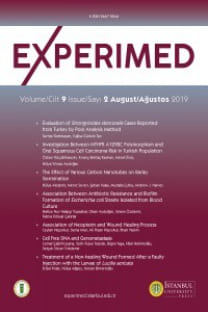İstanbul’da Farklı Sosyo-Ekonomik Seviyeli Okullarda Okuyan Çocuklarda Bağırsak Parazitlerinin ve VRE Taşıyıcılığının Araştırılması
Bağırsak parazitleri, fekal flora, VRE taşıyıcılığı, öğrenciler, farklı sosyo-ekonomik düzeyde okullar
The Investigation of Intestinal Parasites and VRE Carriage in Children Studying in Schools with Different Socio-Economic Levels in İstanbul, Turkey
Intestinal parasites, fecal flora, VRE carriage, students, schools with different socio-economic level,
___
- 1. Curtale F, Pezzotti P, Sharbini A, Al Maadat H, Ingrosso P, et al. Knowledge, perceptions and behaviour of mothers toward intestinal helminths in upper Egypt: Implications for control. Health Policy Plan 1998; 13: 423-32. 2. Bethony J, Brooker S, Albonico M, Geiger SM, Loukas A, et al. Soil-transmitted helminth infections: Ascariasis, trichuriasis, and hookworm. Lancet 2006; 367: 1521-32. 3. Pillai D, Kain K. Common intestinal parasites. Curr Trea Options Infect Dis 2003; 5: 207-17. 4. Minenoa T, Avery M. Giardiasis: Recent progress in chemotherapy and drug development. Curr Pharm Des 2003; 9: 841-55. 5. Keiser J, Utzinger J. The drugs we have and the drugs we need against major helminth infections. Adv Parasitol 2010; 73: 197-230. 6. Evans AC, Stephenson L. Not by drugs alone: The fight against parasitic helminths. World Health Forum 1995; 16: 258-61. 7. Ulukanlıgil M. The results of a control program carried out on school children for intestinal parasites in Sanliurfa province, Turkey between the years of 2001 and 2005. Turkiye Parazitol Derg 2006; 30: 39-45. 8. Okyay P, Ertug S, Gultekin B, Onen O, Beser E. Intestinal parasites prevalence and related factors in school children, a western city sample-Turkey. BMC Public Health 2004; 4: 64. 9. Hamamcı B, Cetinkaya U, Delice S, Erçal BD, Gücüyetmez S, Yazar S. Investigation of intestinal parasites among primary school students in Kayseri-Hacılar. Turkiye Parazitol Derg 2011; 35: 96-9. 10. Ekinci B, Karacaoğlan E, Bulucu E, Sül N. Investigation of intestinal parasites among elementary school students in the Mugla province. Turkiye Parazitol Derg 2011; 35: 92-5. 11. Köksal F, Başlanti I, Samasti M. A retrospective evaluation of the prevalence of intestinal parasites in Istanbul, Turkey. Turkiye Parazitol Derg 2010; 34: 166-71. 12. Oner YA, Dinçer N, Büget E. Istanbul Tıp Fakültesinde 1985-1995 yılları arasında incelenen 39226 dışkı örneğinde parazitolojik bulgular. Turkiye Parazitol Derg 1997; 21: 167‐8. 13. Unat EK, Altaş K, Öztürk R, İsenkul R, Öztürk M, Köksal F, et al. İstanbul’un değişik semtlerinde insan serbest dışkısının yayılışı, 15 ve 30 yıl öncesine göre durum. Cerrahpaşa Tıp Fak Derg 1989; 20: 179‐84. 14. Tang N, Luo NJ. A cross‐sectional study of intestinal parasitic infections in a rural district of west China. Can J Infect Dis 2003; 14: 159‐62. 15. Arani AS, Alaghehbandan R, Akhlaghi L, Shahi M, Lari AR. Prevalence of intestinal parasites in a population in South Tehran, Iran. Rev Inst Med trop Sao Paulo 2008; 50: 145‐9.
- Yayın Aralığı: Yılda 3 Sayı
- Başlangıç: 2011
- Yayıncı: İstanbul Üniversitesi
Evde Bakım Hastalarının Laboratuvar Özellikleri
Zeynep KARAALİ, Beste TACAL ASLAN, Mehmet Burak AKTUĞLU, Macit KOLDAŞ, Elif Sinem İPLİK, Bedia ÇAKMAKOĞLU
Fatma KÖKSAL ÇAKIRLAR, Sevilay YILDIZ, Okan AYDOĞAN, Sinem ÖZDEMİR, Sercan AKYOL ÇOLAKOĞLU, Zeynep TANER, Halit TOKMAN, Nevriye GÖNÜLLÜ
Resul KAHRAMAN, Veysel HANCER, Arzu ERGEN, Bedia ÇAKMAKOĞLU, Reyhan DİZ KÜÇÜKKAYA
CD247 Genine Ait rs858554 ve rs704848 Polimorfizmlerinin İmmün Trombositopeni Hastalığı ile İlişkisi
İbrahim KUTLUBAY, Elif Gülsüm ÜMİT, Jülide TOZKIR
İki Tilmikosin Preparatının Koyunlarda Biyoeşdeğerliği
Osteointegre Dental İmplant Tedavisi Gören Hastalarda IL-1 β Genotipi ve Seviyelerinin İncelenmesi
Ferhat DİZEN, Uzay GÖRMÜŞ, Arzu ERGEN, Meral ÜNÜR, Elif Sinem İPLİK, Bedia ÇAKMAKOĞLU, Turgay İSBİR
Elif ŞAHİN, Nurten DAYIOĞLU, Baransel ÖKMEN, Ezgi KORKMAZ, Şevval BAYKARA, Gül BAKTIR
